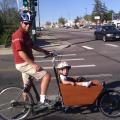Resource Library
This report shows that physical activity among adults and high school students is higher in some states than others. Overall, most states have environmental and policy strategies in place that encourage physical activity.
As many of you know, it’s award season! From the Golden Globes to the Screen Actor's Guild Awards and all the way to the Oscars… there are nominees and winners. Here at the Safe Routes Partnership we wanted in on the award season action. For the past year, the National Shared Use Task Force has been engaging in conversations about ways that we could recognize all of the great work that is happening across the country in the shared use field.
This brief provides an overview of the burden of violence and state strategies to prevent and reduce violence within the context of the social determinants of health—where adolescents live, learn and play.
 Sara Zimmerman is program and policy director at the Safe Routes Partnership.
Sara Zimmerman is program and policy director at the Safe Routes Partnership.
Click here to see the Storify highlights from the #MoveEquity Tweetchat on ending street harassment to get more kids walking and biking.
The majority of Americans live in urban or suburban areas, though around 15 percent of Americans live in nonmetropolitan regions, which make up 72 percent of US land. Although the proportion of Americans who are rural residents has recently declined, these communities still comprise 46.1 million Americans (USDA, 2015). When it comes to health outcomes, researchers have identified inequities in rural areas, including higher rates of obesity compared with urban residents and differing levels of physical activity by geographic region (Yousefian et al., 2009; Hansen and Harley, 2015).
Back in May, we asked you to take action against the US Department of Transportation’s (USDOT) proposed “system performance measures” that would have measured the speed of cars and trucks in seven different ways, while devoting no measures at all to people walking, bicycling, and taking transit.
 In Atlanta, I’m sitting in a conference room with roughly 30 advocates from the public health sector who are here to talk about the work they are doing throughout the country in preventative health.
In Atlanta, I’m sitting in a conference room with roughly 30 advocates from the public health sector who are here to talk about the work they are doing throughout the country in preventative health.
 Since the release of the Senate transportation bill back in November, we have faced the specter of a transportation bill in which state departments of transportation would make the sole decisions about whether to dedicate any funding to Safe Routes to School, bicycling and walking.
Since the release of the Senate transportation bill back in November, we have faced the specter of a transportation bill in which state departments of transportation would make the sole decisions about whether to dedicate any funding to Safe Routes to School, bicycling and walking.
 On Wednesday, March 14, the full Senate passed MAP-21, a two-year transportation reauthorization bill (more details).
On Wednesday, March 14, the full Senate passed MAP-21, a two-year transportation reauthorization bill (more details).
 Whoever says rules are made to be broken is not aware of this interesting fact: Safe Routes to School-related laws have been effective in reducing injuries and increasing walking and bicycling to school.
Whoever says rules are made to be broken is not aware of this interesting fact: Safe Routes to School-related laws have been effective in reducing injuries and increasing walking and bicycling to school.
 May is National Bike Month, and May 9 marks the first ever official National Bike to School Day. Events celebrating bicycling and encouraging more ridership are taking place all throughout the country. The weather is warm, spring has sprung and
May is National Bike Month, and May 9 marks the first ever official National Bike to School Day. Events celebrating bicycling and encouraging more ridership are taking place all throughout the country. The weather is warm, spring has sprung and
 Jeanie Ward-Waller is a structural engineer who also holds two masters degrees. After working as a civil engineer on building construction for four years, Jeanie decided to do something big, bold and very different.
Jeanie Ward-Waller is a structural engineer who also holds two masters degrees. After working as a civil engineer on building construction for four years, Jeanie decided to do something big, bold and very different.
 Katie Couric said on CBS national news, ‘There is something so right about a kid on a bike’.
Katie Couric said on CBS national news, ‘There is something so right about a kid on a bike’.
 As I have reflected on yet another busy month with the Regional network project, I have thought about why the work the regional policy managers are doing is so unique, yet so pivotal, at this point in time.
As I have reflected on yet another busy month with the Regional network project, I have thought about why the work the regional policy managers are doing is so unique, yet so pivotal, at this point in time.
 Please excuse the divergence from our regularly scheduled content.
Please excuse the divergence from our regularly scheduled content.

The Connecticut Safe Routes to School program is making progress in providing safe walking and bicycling improvements around schools and communities! The Safe Routes to School infrastructure program just recently completed its fourth funding cycle, awarding more than $3 million in funding. Six awarded projects will benefit nine schools in six communities around the state with improvements such as sidewalk installation, bike lanes, multiuse paths, school zone signs and pavement markings.
 This month has been a tough one for Safe Routes to School supporters.
This month has been a tough one for Safe Routes to School supporters.

